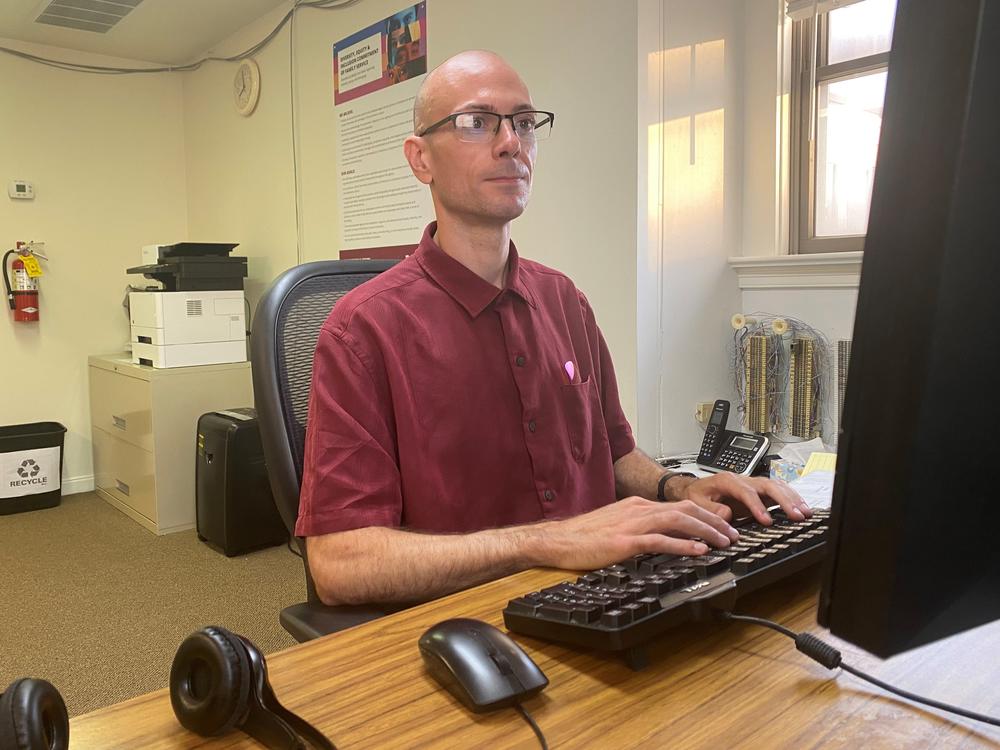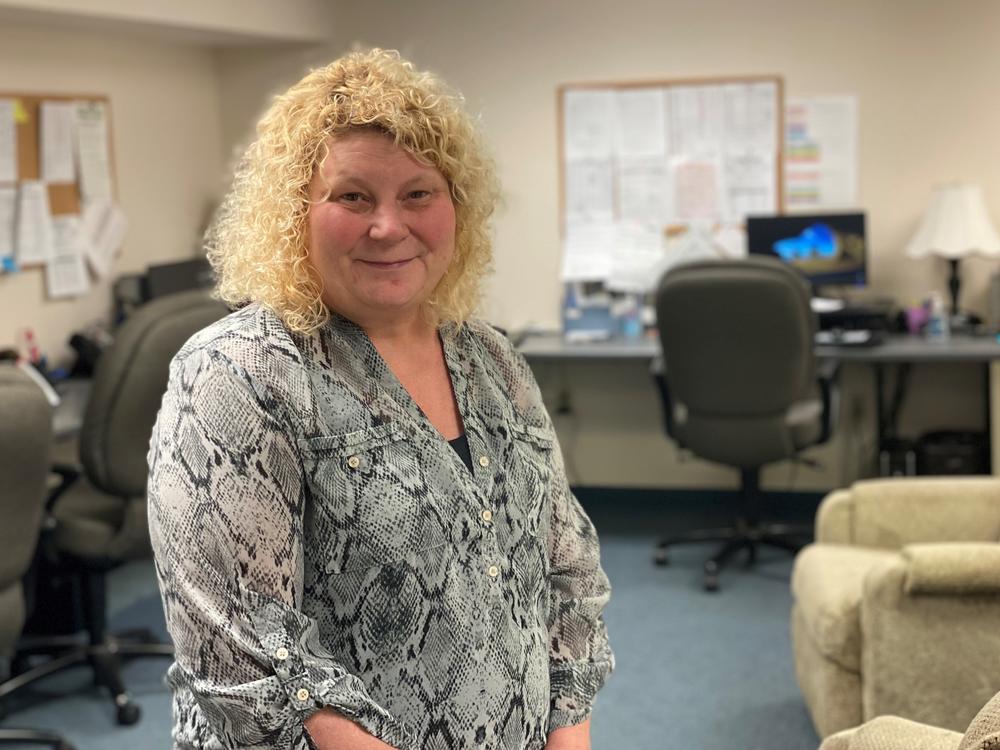
Section Branding
Header Content
At 988 call centers, crisis counselors offer empathy — and juggle limited resources
Primary Content
On a Friday evening at a call center in southeastern Pennsylvania, Michael Colluccio stirs his hot tea, puts on his headset, and starts up his computer. On the screen, calls are coming in to the suicide prevention lifeline from around the state.
The 38-year old Colluccio says he knows what it's like to be on the other end of one of those calls.
"So I had a suicide attempt when I was about 10, 11 years old," Colluccio says. "And we do get callers who are about that age, or quite young, and they are going through similar stressors."
For people having a mental health crisis, calling 988 can be a life-saving decision. But what happens after you call depends on where you are. The new 988 system launched in mid-July, and one early estimate says calls went up 45% nationally during the first week.
With calls expected to increase more as people learn about the helpline, some call centers say there are limits to what they can accomplish without more local resources.
Colluccio says callers in this area — Bucks County, a suburb of Philadelphia — have access to more services than in many parts of the state. His job with the Family Service Association, which runs the hotline, sometimes involves connecting them with services such as homeless shelters, therapists or drug and alcohol counselors.
More than anything, his job is to listen.
'If you did not pick up, I'd have killed myself'
Colluccio's first call of the evening is from a woman who sounds panicked. Her partner has been using drugs and has started making violent threats.
He spends a lot more time listening than talking. He says by listening closely to what she has to say, he offers relief, validation and human connection.
When he does talk, he usually asks questions — gently searching for specific ways to help. In this case, his questions lead him to connect the caller with local domestic abuse services and a social worker.
One service he rarely turns to is 911. Part of the idea behind 988 is that it offers an alternative to involving police or an ambulance for a mental health crisis. He would typically use 911 only if someone was an immediate threat to themselves or others.
After talking with the woman for a half hour, Colluccio asks her a few key questions to determine whether she feels suicidal. Colluccio says this is an important step to make sure each caller is safe after they hang up.
What happens next is surprisingly common. At the start of the call it seemed like the woman wanted help for her partner. But when he asks her directly on a scale of one to five how suicidal she is, she says she's a two or maybe a three — and she's attempted suicide before.
Before they end the call, Colluccio asks her if she would like a call back tomorrow. She says yes, so he schedules one.
Colluccio has just enough time for a sip of tea when another call comes in. It's a young man in college, overwhelmed by stress. They talk for over an hour.
This is a pretty typical evening.
"Sometimes it's more of an immediate intervention because sometimes people call with pills in hand and are actively considering ending their lives," Colluccio said. "There are people who have called and said, if you did not pick up, I'd have killed myself."
He says that's why having a national network of call centers works so well. There are more than 200 call centers like this one across the country. Calls are tied to area codes. If nobody picks up locally, the call gets kicked to somewhere else.
The promise is to always have someone pick up the phone.
Strained resources for in-person help
In some places, like Bucks County, there are options for callers who need more help than counselors can offer on the phone. Colluccio says he can even dispatch a mobile crew of mental health workers to visit someone at their home.
But that's not the case everywhere. In Hanover, a small town a few hours west, the 988 call center doesn't have that option.
Jayne Wildasin runs that center and says workers sometimes have to put down their headsets, get in their cars and go meet with people sometimes as far as an hour away.
"So right now if there's a crisis at someone's house we could potentially go there," Wildasin says.
In rural Centre County, the local 988 call center relies on volunteers — mostly college students from Penn State University. Denise Herr McCann runs the operation and says that her team can call in mobile mental health experts, but there need to be more of them.
Plus there's a gaping need for other mental health professionals to continue helping people once the crisis has passed.
"Sometimes those resources are other counseling services, and they don't have capacity," Herr McCann says. "People are calling, and providers are six weeks out if they're lucky. That's not any good."
For decades, suicide prevention call centers have had to scrape together funding from local, state and federal sources. Now with the switch to 988, they have to meet new federal regulations, such as data collecting and licensure requirements, says Julie Dees, who oversees the call center in Bucks County. That all costs money.
"There are increased responsibilities that are being put on the call centers, but there's really no additional funding being put on that," Dees says.
It's an issue around the U.S., according to a recent analysis from The Pew Charitable Trusts. The group notes that states are largely left to foot the bill for the change to 988 — and many of the call centers doing the actual work have been underfunded for years. It recommends that state policymakers evaluate funding needs to ensure that crisis services connected to 988 will be sustainable.
The Biden administration has dedicated $432 million toward building the capacity of local and backup call centers and providing associated services. But the expectation is that states will come up with the main funding streams.
The 2020 law enacting the 988 number also allows states to pass legislation to add a small fee to cell phone bills as a permanent source of funds for 988 and associated mental health services. So far, only four states have done so, and only two more have proposed legislation.
Pennsylvania is not one of those states, and doesn't have any other funding plan implemented. That worries Kevin Boozel, who heads the County Commissioners Association of Pennsylvania.
"This is life or death," Boozel says. "And you can't halfway do it."
He pointed out that Pennsylvania has decided to hold back on publicizing the new 988 number until next year. The fear is that too many calls could flood the system, and counties need more time to set up funding, hire workers and build capacity for things like those mobile crisis teams.
Challenges aside, In Centre County, Herr McCann emphasizes that calling the hotline works. In most cases, just talking with someone is enough to defuse a crisis.
"When they have someone who is empathetic and who listens, that connection helps them," she said. That lets people know that "it isn't hopeless. There is hope out there. There is help out there."
Copyright 2022 WITF. To see more, visit WITF.


